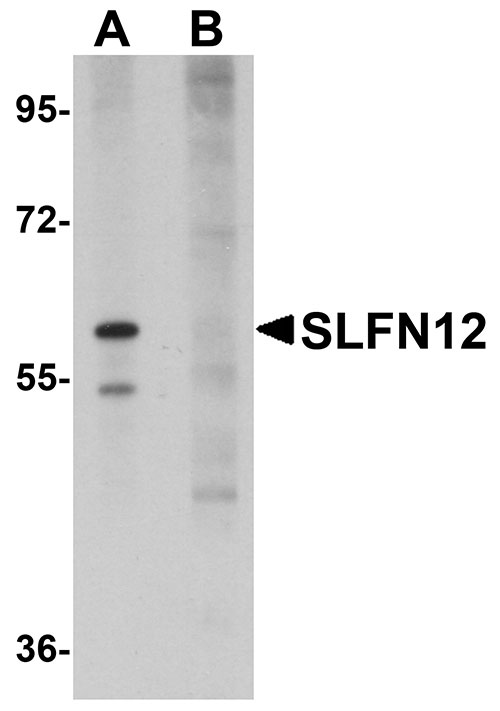SLFN12 Antibody
- SPECIFICATION
- CITATIONS
- PROTOCOLS
- BACKGROUND

Application
| WB, E |
|---|---|
| Primary Accession | Q8IYM2 |
| Other Accession | NP_060512, 157388955 |
| Reactivity | Human |
| Host | Rabbit |
| Clonality | Polyclonal |
| Isotype | IgG |
| Calculated MW | 66972 Da |
| Application Notes | SLFN12 antibody can be used for detection of SLFN12 by Western blot at 1 µg/mL. |
| Gene ID | 55106 |
|---|---|
| Target/Specificity | SLFN12; |
| Reconstitution & Storage | SLFN12 antibody can be stored at 4℃ for three months and -20℃, stable for up to one year. As with all antibodies care should be taken to avoid repeated freeze thaw cycles. Antibodies should not be exposed to prolonged high temperatures. |
| Precautions | SLFN12 Antibody is for research use only and not for use in diagnostic or therapeutic procedures. |
| Name | SLFN12 (HGNC:25500) |
|---|---|
| Function | Ribonuclease which is part of an E2/17beta-estradiol-induced pro-apoptotic signaling pathway. E2 stabilizes the PDE3A/SLFN12 complex in the cytosol, promoting the dephosphorylation of SLFN12 and activating its pro-apoptotic ribosomal RNA/rRNA ribonuclease activity. This apoptotic pathway might be relevant in tissues with high concentration of E2 and be for instance involved in placenta remodeling (PubMed:31420216, PubMed:35104454, PubMed:34272366, PubMed:34707099). May play a role in cell differentiation (PubMed:30045019). |
| Cellular Location | Nucleus. Cytoplasm, cytosol |

Thousands of laboratories across the world have published research that depended on the performance of antibodies from Abcepta to advance their research. Check out links to articles that cite our products in major peer-reviewed journals, organized by research category.
info@abcepta.com, and receive a free "I Love Antibodies" mug.
Provided below are standard protocols that you may find useful for product applications.
Background
SLFN12 Antibody: Despite being first described several years ago, the roles of the Schlafen (SLFN) family of proteins remain largely unknown. The SLFN genes are preferentially expressed in lymphoid tissues and differentially regulated during thymocyte maturation. It is thought that many play roles in cell growth, hemopoietic cell differentiation, and T cell development and maturation. Most members contain at least one divergent AAA domain (AAA_4) that may play a role in ATP binding. Although also known as SLFN3, a Schlafen family member that may be a marker of T cell activation, human SLFN12 has relatively low homology to SLFN3 in other species. Loss of the SLFN12 gene due to deletion is associated with Kabuki syndrome, a multiple congenital anomaly syndrome, suggesting SLFN may play a role in this genetic condition.
References
Schwarz DA, Katamaya CD, and Hedrick SM. Schlafen, a new family of growth regulatory genes that affect thymocyte development. Immunity1998; 9:657-68.
Bustos O, Naik S, Ayers G, et al. Evolution of the Schlafen genes, a gene family associated with embryonic lethality, meiotic drive, immune processes and orthopoxvirus virulence. Gene2009; 447:1-11.
Condamine T, Le Laduec J-B, Chiffoleau E, et al. Characterization of Schlafen-3 expression in effector and regulatory T cells. J. Leuk. Biol.2010; 87:1-6.
Cusco I, del Campo M, Vilardell M, et al. Array-CGH in patients with Kabuki-like phenotype: Identification of two patients with complex rearrangements including 2q37 deletions and no other recurrent aberration. BMC Med. Gen.2008; 9:27.
If you have used an Abcepta product and would like to share how it has performed, please click on the "Submit Review" button and provide the requested information. Our staff will examine and post your review and contact you if needed.
If you have any additional inquiries please email technical services at tech@abcepta.com.













 Foundational characteristics of cancer include proliferation, angiogenesis, migration, evasion of apoptosis, and cellular immortality. Find key markers for these cellular processes and antibodies to detect them.
Foundational characteristics of cancer include proliferation, angiogenesis, migration, evasion of apoptosis, and cellular immortality. Find key markers for these cellular processes and antibodies to detect them. The SUMOplot™ Analysis Program predicts and scores sumoylation sites in your protein. SUMOylation is a post-translational modification involved in various cellular processes, such as nuclear-cytosolic transport, transcriptional regulation, apoptosis, protein stability, response to stress, and progression through the cell cycle.
The SUMOplot™ Analysis Program predicts and scores sumoylation sites in your protein. SUMOylation is a post-translational modification involved in various cellular processes, such as nuclear-cytosolic transport, transcriptional regulation, apoptosis, protein stability, response to stress, and progression through the cell cycle. The Autophagy Receptor Motif Plotter predicts and scores autophagy receptor binding sites in your protein. Identifying proteins connected to this pathway is critical to understanding the role of autophagy in physiological as well as pathological processes such as development, differentiation, neurodegenerative diseases, stress, infection, and cancer.
The Autophagy Receptor Motif Plotter predicts and scores autophagy receptor binding sites in your protein. Identifying proteins connected to this pathway is critical to understanding the role of autophagy in physiological as well as pathological processes such as development, differentiation, neurodegenerative diseases, stress, infection, and cancer.


